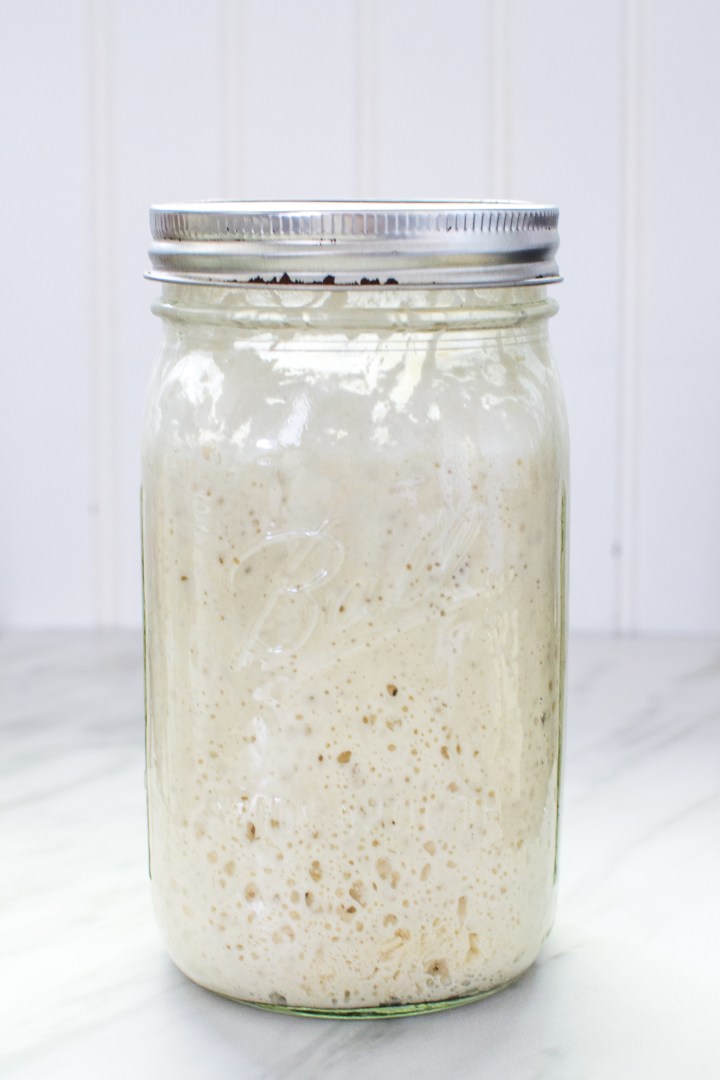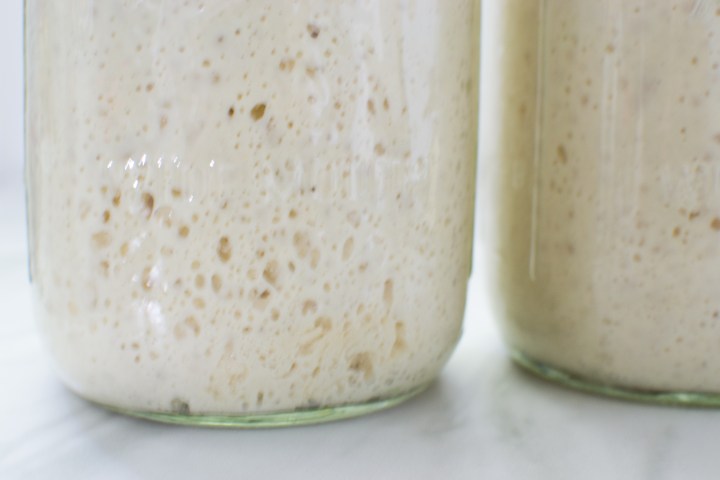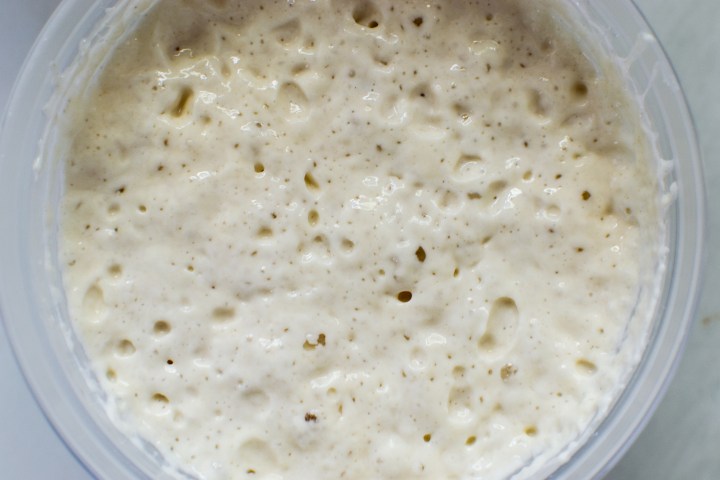
During quarantine, most of us have picked up a new hobby or two. I have always been fascinated with sourdough, but I was just always really confused by a lot of the language these bakers used (feeding, levain, discard, hooch, etc.) AHHHHHH!!! But with the extra time on my hands, I decided to buckle down and learn about sourdough. As it turns out, it’s not as difficult as I thought. Honestly, if I can do it, so can you! I’m going to break this down to the barebones basics of sourdough. Think of this as Sourdough 101. Throughout this post, I’ll explain creating a starter, feeding it (aka keeping it healthy and happy), and how to use it.

TO CREATE A SOURDOUGH STARTER
You’ll need just 3 simple ingredients – warm water, yeast, and all-purpose flour. It is important that your water is warm so it can “activate” the yeast, but not scalding hot that it kills the yeast. For the flour, I’ve read that it is a good idea to buy one brand of flour and stick with it, at least for a while, since different brands of flours have different protein contents. It’s best to keep it consistent (i.e. if you use white flour, use white flour, if you use whole wheat, stick with that). But in the unlikely case that your go-to flour isn’t on the store shelves, just make sure you buy all-purpose, unbleached flour.
Sourdough Starter
Ingredients
- 2 cups all-purpose flour
- 2 cups warm water
- 2 1/4 tsp active dry yeast
Method
- In a large, clean glass bowl, whisk together flour and yeast. Pour in water and stir until you have a shaggy dough. Cover and let it sit in a warm area (70-80°F), out of direct sunlight, for approximately 7 days.
- Discard any liquid that might have formed on top. Check to make sure there aren’t any pink/orange/black spots in the starter. If mold exists, toss the starter and start again.
- Feed the starter 2-3x before using it to bake.

There are a lot of starter recipes that don’t even use yeast! As your starter grows and blooms, it basically forms its own “wild yeast”. The reason why I chose to do my starter using yeast is that I started this starter in March. Since I live in Philadelphia, the temperatures were still in the 40s-50s, and I knew that it would just be impossible to keep it warm. Some people stick their sourdough in the oven with the light turned on. But since I use my oven so often, that was out of the question. So to give my sourdough starter the best chance at survival, I used yeast.
By the end of the week, your sourdough will probably be really bubbly on top. You will probably have some liquid at the top. This is called hooch. It’s completely harmless, you can stir it back in your starter or discard it. I chose to discard it since my starter had so much hooch.
Your sourdough at this point will be very hungry. So although you might want to start making bread, not yet! We’re going to feed it! Feeding just means keeping it healthy and alive. Since sourdough is a living organism, it needs to feed on something to stay alive!
To feed it, all you’re going to need is 1/2 cup warm water and 1 cup all-purpose flour. Remember, if you can, to use the same one that you used for your starter! So take your sourdough starter, scoop out 1/2 cup of starter and discard the rest. Alternatively, you can just portion them out and make a bunch of starters at the same time! Put your 1/2 cup starter in a clean glass jar, stir in 1/2 cup warm water, and 1 cup all-purpose flour. Stir until you have a shaggy dough. Leave uncovered at room temperature for 2 hours. Then refrigerate.
I like to use a quart-sized mason jar for this, and I snap a rubber band around where the sourdough dough sits after it’s just been fed. After 2 hours, it should double. If your indoor temperature is below 70°F, you might need to let it sit out a little bit longer.
In 2 days, feed it again. At this point, you can use the discard. Since you’re only going to need 1/2 cup starter to start the feeding process, you’re probably left with some sourdough starter to play with. King Arthur Flour has a collection of sourdough recipes that uses the discard only. I’ve tried a handful of them, but my favorites are the pancakes and pizza dough.
If your sourdough starter is looking happy while feeding (lots of bubbles and volume created), then you can wait until a full week before feeding it. If it has some bubbles, but looking a little flat, feed it again in 2 days.
If you’re from California and you’ve visited the Boudin factory, you’ve probably seen the video of how they make sourdough, they take a little starter from the last batch, and after making the dough, pass on another little starter to the next batch. So on and so forth. This is essentially what you’re doing with feeding the sourdough.
After the initial creation of the sourdough starter and 2-3 feedings, you can switch to feeding it only once a week. The process is the exact same.
Sourdough Starter Feeding
Ingredients
- 1/2 cup sourdough starter
- 1 cup all-purpose flour
- 1/2 cup warm water
Method
- In a large non-metal container (i.e. big plastic bin or mason jar), combine sourdough starter, flour, and warm water. Stir until it forms a shaggy dough.
What is the float test? If a recipe calls for fed sourdough starter, and you aren’t sure if your sourdough is ready to use, do the float test. Take a glass of water, drop in a tablespoon of starter. If it floats to the top, it’s ready to use. If it sinks, continue feeding before using it.
What about sourdough bread? Isn’t that what sourdough is all about? So most recipes will tell you exactly what to do with the starter if you’re looking to make bread. What is really consistent across the board is that in order to make bread, you will need a starter that has just been fed. Since most recipes for sourdough bread don’t use any added yeast, you’re relying on the wild yeast in your sourdough starter to create a beautiful rise in your bread. So I typically feed my sourdough starter Sunday morning, so I can have a happy & fed starter that I can use to bake a loaf later that day.
What if I go on vacation and I can’t feed my starter within the week? That was my biggest concern. Is my sourdough starter going to be like my Tamagotchi and die if I ignore it for a prolonged period of time? Most resources I’ve found online say that while it’s unwise to leave it for longer than 1 week, it’s not a lost cause. You’re just going to need to feed it a few times before you can bake with it again. The intervals really depend on how hungry the starter is. For some people, it’s every other day, some it’s every day, others it’s twice a day. The more you feed your starter, the more you understand the usual rise it has when it’s feeding and you can gauge how much the starter needs to bounce back to its original self.
Can I use my sourdough starter in my favorite cake/muffin/scones recipe? Sure you can! To use sourdough starter in a regular recipe, simply weigh out the amount of sourdough starter you want to use (I normally use 1/2 cup to 1 cup), and weigh it. Sourdough starter is essentially 50/50 flour and water, so subtract the weight from what is needed from the recipe.
